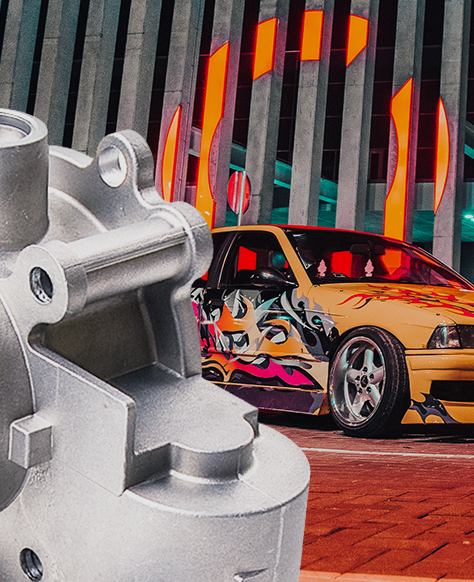Throttle Body Buyer's Guide
What is a throttle body?
The Throttle Body is a device located in the engine compartment, between the intake manifold and air
intake pipe.
It is similar to the carburetor but does not regulate fuel flow. The throttle body monitors the amount
of air that can
flow into an engine's combustion chamber. The most important and largest part inside the throttle body
is its throttle plate. This plate has a butterfly valve, which rotates on the throttle shaft. When the
throttle
plate is rotated by the shaft the air flows in and out of the engine.
The throttle body is responsible controlling the
amount of air that flows into an engine. A valve is mounted inside the opening of the throttle body that
opens and closes depending on input from the driver applied through the gas pedal. As the gas pedal is
pushed down, the valve opens, allowing air to enter the engine. As the gas pedal is released, the valve
closes, reducing the amount of air entering the engine.
How throttle body works?
Typically located between the air filter and the intake manifold, the throttle body contains the
delicate throttle system which controls a key component of spark ignition: air flow. Part of the
atomization process, airflow helps regulate the air-fuel mixture ratio required to ignite an engine.
The primary regulator for throttle pressure comes in the form of the throttle body temperature sensor,
which measures the temperature of the air-fuel mixture entering the fuel injection system of your car.
This necessary regulation helps spark ignitions generate the most fuel efficiency.
Largely controlled by the butterfly valve known as the throttle plate, airflow is regulated by the
driver via pressing on the acceleration pedal inside the vehicle. This reacts to a sensor on the
throttle bottle which tells it to allow more air into the combustion chamber, increasing REM and power
output. This makes the car, in turn, go faster.
How to buy a throttle body?
Remember these three simple rules when shopping for a new performance throttle body:
• Confirm that the throttle body you want is emissions-legal in your province or state.
• Bigger is not necessarily better when choosing a throttle body. If you're vehicle is close to stock,
you'll be best off with an only slightly bigger size.
• Think about the future mods you're planning to make. If you're planning major performance upgrades,
invest in a bigger throttle body from the get-to. This will ensure you have the air flow you'll need
down the road.
Why buy throttle body at MaXpeedingRods?
MaXpeedingRods has been engaged in the research of overseas racing products and culture for
decades. If you are looking for throttle body, you have landed at the right place. On the basis
of your vehicle make and model, you can choose from a plethora of automotive maintenance and
accessories. MaXpeedingRods offers a seamless online shopping experience and the streamlined
e-commerce interface makes it easy for you to find just the throttle body you want.
MaXpeedingRods offers a variety of throttle bodies with high quality.
• Brand New Electronic Throttle Body Assembly.
• This Throttle Body is manufactured and tested to the strictest OE standards for unparalleled
performance.
• Built for trouble-free ownership and 100% visually inspected and quality tested.
• This Throttle Body is backed by our 100% satisfaction guarantee.
• 100% electrically tested prior to leaving the factory.
• 100% factory test.
• Top quality Aftermarket part.
• Professional Installation is Highly Recommended.
• No Instruction Included For professional assistance, you can reach out to us via our
website.

What are the symptoms of a bad or failing throttle body?
In today's modern fuel injected cars, the throttle body is a critical piece of the air intake system
that controls the amount of air flowing into the engine. The amount of air allowed in is a function of
how far the driver presses the accelerator pedal to the floor. As you press down on the pedal, a sensor
called a throttle position sensor receives a signal relative to where your foot is, ranging from all the
way up (zero acceleration), to all the way down (full acceleration). This sensor relays this information
to the car's main computer giving it constant updates as to the position of the throttle. The position
of the pedal along this range is how the computer knows what to tell the fuel injection system in terms
of how much more or less fuel to inject into the system.
When this process is regulated properly, a perfect balance of air and fuel is introduced to your car's
engine, allowing it to run smoothly and perform at an optimum level. There are a number of reasons that
a throttle body may fail to work properly.
Dirt and grime can build up inside the housing, causing interruption in air/fuel flow. As a result of not having an ordinarily smooth surface for the fuel and air to flow through, this delicate mixture is interrupted with a rough surface which causes an imbalance in flow. Similar to dirt and grime, carbon deposits can create an uneven surface inside the walls of the throttle body which can disrupt the atomization of the air/fuel mixture.
2. Electrical problemsElectrical connection problems can cause inaccurate or intermittent information to be relayed to the car's computer. As with any electrical connection, connectivity issues can cause a wide variety of unpredictable signals to be transmitted. In the case of the throttle body (and related sensor), when this happens it causes inaccurate or intermittent information to be relayed to the car's computer, resulting in faulty corrections to the air/fuel mixture.
3. Vacuum leaks or an incorrectly adjusted throttle stopVacuum leaks can disrupt the air/fuel flow due to an imbalance of air flow which can ctause throttle body pressure problems. The issue could also be an incorrectly adjusted throttle stop. This is a component that acts as a gate-keeper and establishes a minimum or maximum position for a throttle body plate to be opened or closed.
4. Poor or high idleWhen a throttle body is not functioning correctly, some noticeable characteristics may be poor or very low idle. This can include stalling when coming to a stop or very low idle after starting, or even stalling if the throttle is quickly pressed (resulting in the throttle body plate opening and closing very quickly). In the case of a vacuum leak, you may experience a very high idle, which is caused by too much air being allowed into the intake system. This typically is caused by a fairly large vacuum leak. All of these symptoms will contribute to poor engine performance and as a result will cause your check engine light to come on.

How to replace a throttle body in a car?
The throttle body is the part of the engine that mixes air with the fuel to allow combustion to take
place. There are a number of symptoms that are often due to a failure in this part, including repeated
stalling for no reason, problems with responsiveness of the acceleration pedal and stumbling or
hesitation whilst accelerating.
Before completely replacing the throttle body it is always advisable to check that this part is clean
and free from dirt. If you find that you are still having repeated acceleration issues with your car
following the cleaning process, then throttle replacement is the next step. Due to the complex
connections on the throttle body together with the procedure necessary to ensure that this part is
safely in place, we would only recommend taking on this job if you have a good mechanical knowledge.
screwdrivers, socket set, spanners, needle pointed pliers.
1. Remove the Hose from the Throttle BodyMaking sure that your engine is turned off, open the bonnet and locate the air filter case. When you have found this part, carefully follow the large hose using your hand until you reach the clamp connecting it to the engine. This is the throttle body. Next remove the hose from its seating and pull it away from the throttle body.
2. Detach the Air CleanerRemove the air cleaner from the engine, taking care to remove the hoses and ducts that supply the part with clean air. Next carefully unplug the electrical supply alongside any other sensor cables that are attached to the part, for instance in newer cars there may well be a sensor that monitors the air intake temperature, which must also be removed.
3. Deactivate Air Control and Throttle PositionWhen you have removed the air cleaner, deactivate the air control, which should be located on either side of the throttle body. When this is free from the throttle you should be able to disconnect the throttle position sensor, making sure that the leads are kept well away from the site of the throttle.
4. Remove Throttle CablesUsing your hands, gently ease open the throttle body to its full extent. This should give you enough slack to remove the throttle cables one by one. There may also be some water cables attached to the throttle body. If this is the case remove the hose clamps using pliers before you remove the hoses.
5. Unbolt the Throttle BodyLocate the four bolts that attach the throttle body in its place against the intake manifold and unbolt them using a socket set. Then carefully lift the throttle body off the intake manifold taking care to keep the seal between the parts intact.
6. Install the New Throttle Body
Keeping the seal carefully in place, put the new throttle body into its place and connect it to the
intake manifold using the four bolts. When these are sufficiently flush against the fixing then
connect the throttle cables. As a final step you'll need to put the air cleaner back in place before
connecting the hose.
After changing the part, perform the following check as a final test. Start the engine and take the
car for a test drive. On your return, let the engine idle for about two minutes and listen for
problems in the idle, ensuring that it is smooth. If it is not, then there may be additional
problems throughout your engine.







